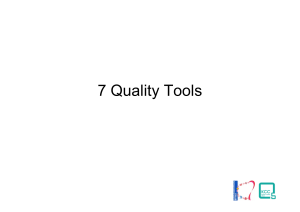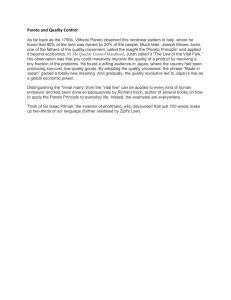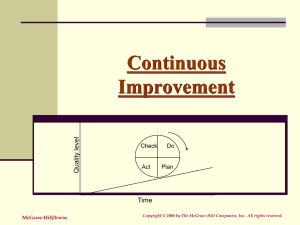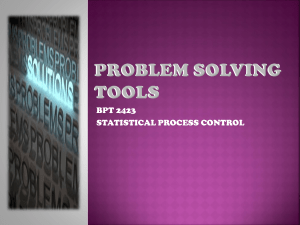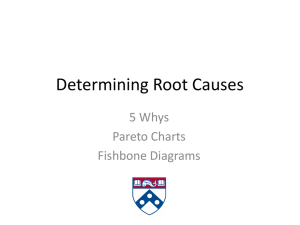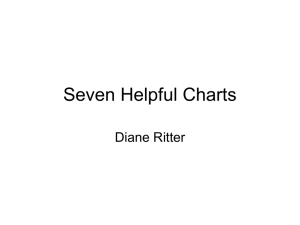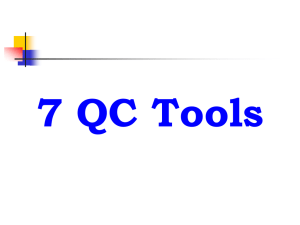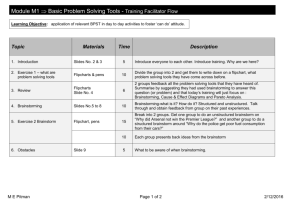QC tools
advertisement
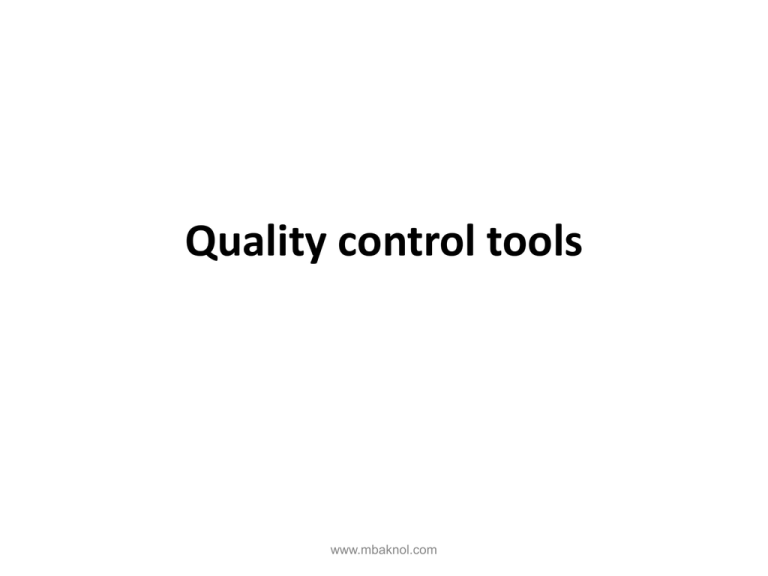
Quality control tools www.mbaknol.com Introduction • Seven QC tools are fundamental instruments to improve the quality of the product. They are used to analyze the production process, identify the major problems, control fluctuations of product quality, and provide solutions to avoid future defects. Statistical literacy is necessary to effectively use the seven QC tools. These tools use statistical techniques and knowledge to accumulate data and analyze them. • Seven QC tools are utilized to organize the collected data in a way that is easy to understand and analyze. Moreover, from using the seven QC tools, any specific problems in a process are identified. www.mbaknol.com 7QC tools always include : • • • • • • • Check Sheet Pareto Chart Cause-and-Effect Diagram Histogram Scatter Diagram Flow Chart Control Chart www.mbaknol.com Check Sheet • A check sheet is a pre-designed format for collection of data that encourages organized collection and groups data into categories. • When to use it: To keep track of the parameters of an on going process. It can be used to track events by such factors as timeliness, reason for inspection failure, etc • How to use it: Look at some preliminary data before developing the check sheet. This will indicate what categories to use. www.mbaknol.com • Used for the collection of quantitative or qualitative repetitive data. Adaptable to different data gathering situations. Minimal interpretation of results required. Easy and quick to use. www.mbaknol.com Pareto Chart • A simple rule, pareto, 20 % issues causes 80 % results. This means, 80 % if problems come from 20 of reasons. 80 % of results come from 20% of work. 80% of cost come from 20% of spent area...and so on. • When to Use Use it when there are many problems or opportunities and you want to focus on the most important. Or when your analyzing data about the frequency of problems or causes in a process. www.mbaknol.com Constructing a Pareto chart: 1.Decide the categories to compare. 2.Determine the appropriate measurement. 3.Decide the period of time for the chart. 4.In a table, collect the data for each category. 5.Arrange the categories in descending way per the total sums. 6.Construct and label bars for each category. 7.Calculate the percentage for each category. 8.Calculate and draw cumulative percentage. • Analysis of the Pareto Chart www.mbaknol.com Cause-and-Effect Diagram (Fishbone Diagram) • The Cause and Effect diagram identifies many possible causes for an effect or a problem. • When to Use When your figuring out the possible factors for a problem. When your team’s thinking hits a roadblock. www.mbaknol.com Procedure • 1- Agree on the problem (effect). • 2- Brainstorm the possible major categories of causes of the problem (5M and 1E). • 3- Write the categories of causes as branches from the main arrow. • 4- Brainstorm all the possible factors for each of the major categories. • 5- Again ask “why does this happen?” about each branch from step 4. • 6 After completion, have the team review the diagram www.mbaknol.com Example: www.mbaknol.com Histogram • shows a bar chart of accumulated data and provides the easiest way to evaluate the distribution of data. • This chart graphs data distributions. If you have numerical, variable, continuous data you can use the this chart. The chart organizes and sorts the data. It shows the data in a pictorial format. www.mbaknol.com Construction • Collect at least 50 data points from a process. • Use the worksheet to set up the chart. • After calculating width in step 2 of the worksheet, use your judgment and adjust it to a convenient round number. • Draw x- and y-axes on graph paper. Mark and label the y-axis for counting the data values. Mark and label the x-axis with the L values from the worksheet. • For each data point, locate it where it fits within the Ls. Mark off one count above the appropriate bar with an X or by shading that portion of the bar. www.mbaknol.com • Scatter Diagram is a graphical tool that plots many data points and shows a pattern of correlation between two variables. • Scatter Diagram Is used to investigate the possible relationship between two variables that both relate to the same "event". When to Use: • When you have paired numerical data. • When trying to identify potential root causes of problems. • After brainstorming causes and effects using a fishbone diagram, to determine objectively whether a particular cause and effect are related. • When determining whether two effects that appear to be related both occur with the same cause. www.mbaknol.com Procedure • • • • • • • • • • • • • • • • 1. Collect pairs of data where a relationship is suspected. 2. Draw a graph with the independent variable on the horizontal axis and the dependent variable on the vertical axis. 3. Look at the pattern of points to see if a relationship is obvious. 4. Divide points on the graph into four quadrants. If there are X points on the graph. 5. Count X/2 points from top to bottom and draw a horizontal line. 6. Count X/2 points from left to right and draw a vertical line. 7. If number of points is odd, draw the line through the middle point. 8. Count the points in each quadrant. 9. Add the diagonally opposite quadrants. 10. A = points in upper left + points in lower right 11. B = points in upper right + points in lower left 12. Q = the smaller of A and B 13. N = A + B 14. Look up the limit for N on the trend test table. 15. If Q is less than the limit, the two variables are related. 16. If Q is greater than or equal to the limit, the pattern could have occurred from random chance. www.mbaknol.com Example www.mbaknol.com Flow Chart • shows the process step by step and can sometimes identify an unnecessary procedure. When to Use: • One of the first activities of a process improvement effort is constructing a flowchart. It provides the following benefits: 1- It give you and everyone a clear understanding of the process. 2- Facilitates teamwork and communication. 3- Helps to identify non-value-added operations. www.mbaknol.com Method: • • There are many symbols used to construct a flowchart; the more common symbols are shown below: Identify the process steps and link them together with direction arrows www.mbaknol.com Control Chart • provides control limits which are generally three standard deviations above and below average, whether or not our process is in control. • Control charts are graphs used to study how a process changes over time. • Data is plotted in time order. A control chart always has a central line for the average, an upper line for the upper control limit and a lower line for the lower control limit. These three lines are determined from historical data. www.mbaknol.com When to Use: • • When controlling ongoing processes by finding and correcting problems as they occur. • • When predicting the expected range of outcomes from a process. • • When determining whether a process is stable (in statistical control). • • When analyzing patterns of process variation from special causes (nonroutine events) or common causes (built into the process). • • When determining whether your quality improvement project should aim to prevent specific problems or to make fundamental changes to the process. www.mbaknol.com Basic Procedure • 1. Choose the appropriate control chart for your data. • 2. Determine the appropriate time period for collecting and plotting data. • 3. Collect data, construct your chart and analyze the data. • 4. Look for “out-of-control signals” on the control chart. When one is identified, mark it on the chart and investigate the cause. Document how you investigated, the root cause and how it was corrected. www.mbaknol.com Example www.mbaknol.com

